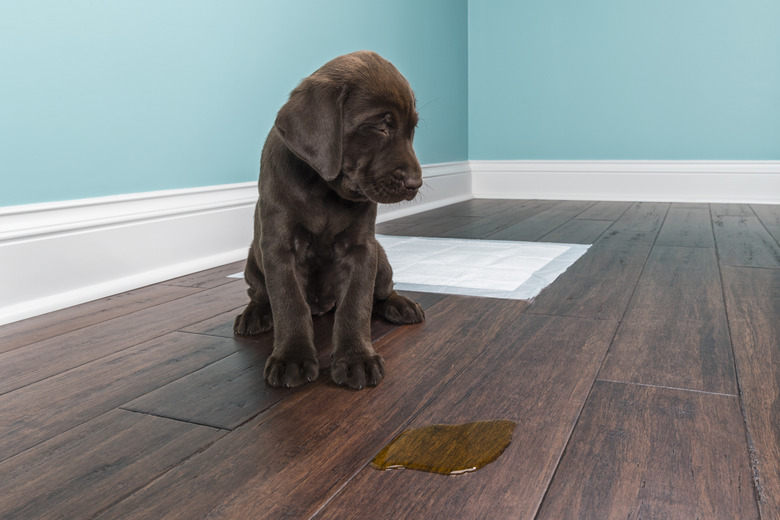Does Vinegar Kill Dog Urine Odor In Hardwood Floors?
No one likes the smell of urine —except maybe dogs who decide that the smell is a great way to learn about other dogs. Even when it's their own urine, it seems to serve as a wonderful indicator of where they should go pee in the future. Whether your pooch is still being potty trained, was left inside too long, or is having a harder time holding in his urine in his old age, it's pretty common for dog owners to find their pups have "accidents" every now and again. If you have hardwood floors, it's important to find something that will clean the mess and remove the stain so your dog won't be tempted to pee on the same spot over and over again. Fortunately, vinegar can do that for you.
Vinegar neutralizes urine smell
Vinegar neutralizes urine smell
Vinegar is great at removing the smell of pet urine from all kinds of surfaces. That's because urine contains ammonia, bacteria, hormones, nitrogen, and uric acid, according to Pet Poo Skiddoo, and soap cannot break down these chemicals—but vinegar does. On top of breaking down these stinky urine components, vinegar is a natural germ killer, able to kill 99 percent of bacteria, 80 percent of germs, and 82 percent of molds.
Dog urine on wood floors
Dog urine on wood floors
So if vinegar does such a great job at getting rid of urine, should you just dump it on the area to remove the smell of dog pee on hardwood floors? Well, that's a surprisingly controversial question. As it turns out, cleaning experts debate whether or not you should ever apply vinegar to hardwood floors. For example, Bona writes that you should "avoid water and vinegar to best clean hardwood floors," claiming that vinegar's acidic properties will break down the finish on your floor, reducing the shine over time. The site also states that diluting the vinegar with water could lead to too much water sitting on your floor, which could cause swelling and discoloration of the hardwood.
On the other hand, Clean Mama argues that by diluting the vinegar, you bring the pH closer to neutral, making it no longer a threat to your floors staining. The site also says that you should clean and dry your floor section-by-section, which will prevent water from standing too long, causing it to sink into the floor and cause damage.
This debate rages on and seems to apply no matter what specific stain or type of wood flooring is in question, including waxed and unfinished floors. The only type of hardwood floor that everyone agrees on is engineered hardwood floors, which Floor Critics explains should never be cleaned with vinegar.
The bottom line is that while vinegar is useful in getting rid of dog urine smell on wood, you need to consider whether or not using it may damage your floor. If you do decide to use vinegar to remove dog pee on your wood floor, always dilute it first and test the solution in an inconspicuous part of the floor first.
Consider baking soda
Consider baking soda
While vinegar's acidity can strip away the finish of a hardwood floor, baking soda is an alkali base with many of the same benefits when it comes to removing dog urine on wood floors. It absorbs the smell and breaks down the chemicals in the urine, but does not damage the flooring finish. Baking soda can be abrasive and may scratch floor surfaces if used too frequently, but if you remove the smell, hopefully, your dog will not go to the bathroom on the same spot multiple times.
To use baking soda to clean urine smell, sprinkle it on the floor, let it sit for a few hours and then vacuum it up or scrub it off with a sponge. You can even apply baking soda while the pet stain is still wet to absorb some of the liquid. Because baking soda does not disinfect, but only removes urine odor, follow up with your usual floor cleaner.
Vinegar and baking soda together?
Vinegar and baking soda together?
Many sources recommend combining vinegar and baking soda to make a super cleaner that has the benefits of both products. It's a logical thought, but not only will this present double the threat to your hardwood floor, but it will also make each product weaker than it would be on its own. Since vinegar is an acid and baking soda is a base, combining the two cancels out many of the properties that make them work well in the first place.
